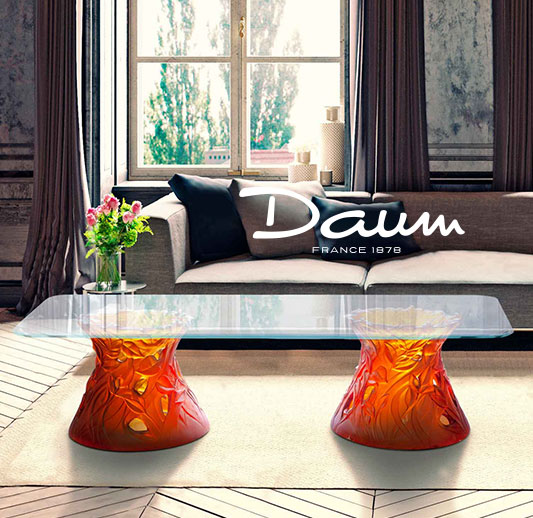To offer you a better experience, this site uses profiling cookies, even from third parties. By continuing to browse our site you accept our cookie policy. Find out more.
French crystal studio DAUM

The famous French crystal studio Daum dates back to 1878 when Jean Daum, a lawyer with no glassmaking experience, took the Sainte-Catherine glassworks in Nancy as payment for an outstanding debt. His two sons soon became partners in the business, August in 1879 and Antonin in 1887. August’s management and Antonin’s creative talent gave the business a new economic and artistic dimension, production broadened from simple tableware and drinking glasses to acclaimed and highly coveted decorative art glass pieces. There have been four major eras in the art glass produced by Daum, namely Art Nouveau, Art Deco, Crystal, and Nouveau Pate-de-verre. Each change in style coincided with a new generation of the Daum family taking over, and keeping the company abreast of current taste and fashions.
The 1889 World Exposition and the objects exhibited by Art Nouveau master Emile Gallé, also working in Nancy at the time, greatly inspired the Daum brothers to produce colored glass in a naturalistic style similar to Gallé’s. The team created pieces with Japanese inspiration, using asymmetric, organic forms with subtle colors.
The factory also incorporated newly developed techniques into their production. “Cameo”, or overlay glass, was one of these new techniques and involved casing glass with one or two layers of a different color and engraving the design on the surface. Another, “pâte de verre”, used later, was produced by mixing glass crystals with metallic oxides and an adhesive, and fusing them by firing in a mould.
Charles Schneider designed for Daum and developed “intercalaires”, or inclusions of colored flecks and streaks between two layers of glass, the firm patented the technique in 1899.
By 1893 the Daums' lamps, directly inspired by Emile Gallé, were produced in acid-etched cameo. These lampes-fleurs, displayed at the 1900 International Exposition, gained critical acclaim and established the firm as innovators in the art glass market.
The style of glass made after World War 1 were influenced by the work of Maurice Marinot. Their forms became more formal, and the glass walls quite thick – all the better to transmit interesting light effects through the various surface treatments of the glass. Often, flecks of silver or gold metal were mixed into the glass, reflecting light and adding a subtle sparkle.
In 1965 another generation of Daum's took over. They invited a number of famous sculptors, designers, and master glass artists, to design special limited editions for the company. Salvador Dali was the first, Cesar the second, and the series has been an outstanding success.
Later, Daum worked with hundreds of artists and designers such as Arman, Hilton McConnico, Richard Texier, Emilio Robba and Philippe Druillet.
Daum art glass remains highly collectable. A Daum overlay glass lamp made in collaboration with bronze maker Louis Majorelle fetched $1.76 million at Sotheby’s New York in a 1989 auction.
The company is extremely successful today, operating since 1962 as a public company under the name Cristallerie Daum. They make all kinds of figurines in „pate-de-verre” and crystal glass, as well as their high quality tableware.
